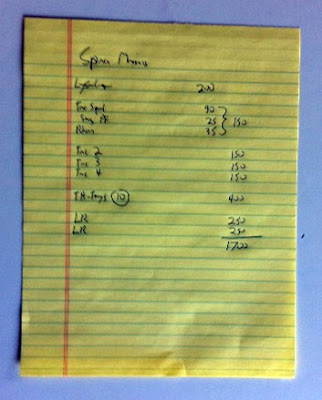My place to talk 40k and gaming - hobby projects, the Aussie community, unit analysis, list-fu and alternative rules. email: kungfumarcus at gmail dot com
Tuesday, January 17, 2012
FoW vs 40k: Writing an Army List
As a 40k veteran dipping my toes into Flames of War, with what I assume is a 40k-centric readership, it seems a good opportunity to write a series of articles comparing elements of the two systems. I know I would have found such content invaluable during my preliminary investigation of Flames of War. If nothing else, it is an opportunity for the reader to increase their FoW literacy.
Building an army in Flames of War is superficially similar to 40k. Firstly you pick a briefing (40k: codex); then take the mandatory HQ and platoons (40k: units); choose additional platoons to taste; then fill up the remaining points with upgrade options. Of course whilst doing this you need to make sure that you maximize the synergies between units, and ensure that your selections can handle tanks, infantry, transports and aircraft.
OK, I lied slightly. Before you can choose your briefing you first need to select a period. Battlefront divide briefings up into three periods: Early War, Mid War and Late War. Those of you with any knowledge of the WWII arms race will know the reason for this - Early War armies have practically no chance of hurting Late War tanks. Such a division is necessary to preserve the internal consistency of the rules system.
Battlefront release large army books that contain many briefings for a particular period - in the vicinity of 20 or more. These books usually cover a single theatre of the war and often contain rules for both sides of the conflict. Battlefront also publish some briefings as free online content, and these are regarded as official within the community. One force may have many briefings available, covering its construction through a variety of battles and time periods. For example there are at least 5 briefings that I know of for Briitsh Airbourne forces, covering both Mid and Late War.
Briefings represent a company of soldiers, plus the divisional assets that have been allocated to them (except for Russians - they come in bulk). One important property of a company that you should understand is that they are are divided into three broad groups: Infantry, Mounted Infantry and Tank. Infantry always defend against Mounted or Tanks, and Mounted always defend against Tanks. This doesn't mean that an Infantry Company can't take tanks - they are still available as divisional assets, just in smaller numbers.
All the briefings I have seen have a mandatory HQ and 2 mandatory platoons of basic troops/tanks. For example my paratroopers will set you back 400 points at a minimum, 580 if you add the usually taken options. this minimum spend is even bigger I believe for Tank companies - although they can often choose the type of tank in their main platoons. So as you can see a reasonable chunk of points is spent on mandatory purchases.
Now you need to choose supporting units. You know - stuff that covers the weakness of your core force and/or enhances what you already have. Of course you are looking for synergies to get the most of your force, but I think most options come with an inherent synergy to the core - just like they did in real life.
You will need to make sure that you have the tools to take on all the types of forces you might face, just like in 40k. Fast units to steal objectives ad reinforce, anti-tank guns to destroy tanks and vehicles at range, machine guns and mortars to pin, smoke to delay opponents, and templates to massacre hordes. It's the same balancing act and seems to leverage the skills I already have in list writing.
At this point I started to list all the different types of units and the support that they provide, but this ended up being enough content for a separate article!
Finally you will want to spend any remaining points, or save a few points off your list to reach the required total. This can be quite awkward as there are often very few options in Flames of War - for many units the only options relate to unit size, and the difference might be 40-60 points or even more (for tank forces).
The most noticeable difference when building a list is the lack of variety in the platoons available to you to spend your hard-earned points on. I think the primary reason for this is that non-core units can only be taken once! A few units are listed multiple times but on the whole it's difficult to spam anything besides your combat platoons ("troop" choices). Thinking about how lists are built in 40k and you will start to realize the significance of this difference. For example my 1500 point army fills 9 of the 14 available units - a full 2/3 of the total possible options for that briefing.
So what does this mean for Flames of War lists? I think the point I want to make I that lists from the same briefing end up being relatively similar. And most lists have the tools required to win games. This moves the focus off list building and on to strategy and tactics, which I like to see. Yay - that means less restless nights spent trying to conceive the killer list for the latest meta!
Subscribe to:
Post Comments (Atom)

The significant difference between the 2 is that FOW lists are based on the armys historical organization. In all ww2 armies, the majority troop type is rank and file. This is reflected in the fow list and is a good thing as it makes it more difficult to make up super armies
ReplyDelete